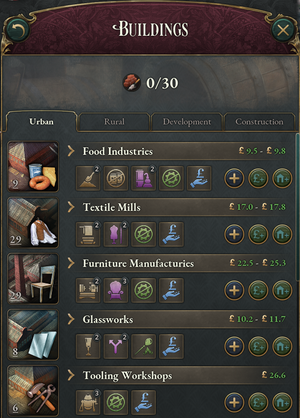| 第17行: | 第17行: | ||
一般来说,建筑可以分为以下几类: | 一般来说,建筑可以分为以下几类: | ||
* ''自给建筑'' - 自给建筑是一种特殊的低效率 | * ''自给建筑'' - 自给建筑是一种特殊的低效率 建筑 ,不能被手动建造或者摧毁,但是会在世界上任何未 使用的可 耕 土 地存在。游戏开始时,世界上的绝大多数人口都以 {{icon|peasants|21px}}自给农的职业在自给建筑工作。私人所有制下,自给建筑还会提供{{icon|Clergymen|21px}}教士和{{icon|Aristocrats|21px}}贵族的岗位。在自给建筑中工作的人口对GDP和税收贡献甚微,游戏进行工业化的过程中,会为自给农提供更有生产力的就业机会。 | ||
* | * 城镇中心 - 另一种特殊建筑,类似自给建筑,这些建筑是自动创建而非手动建造的。一个地区的城镇中心等级与其本地建筑产生的城镇化程度相关,每有100城镇化就会创建一级城镇中心。城镇中心主要提供{{icon|shopkeepers|21px}} 店主和{{icon|Clergymen|21px}}教士岗位,并生产服务。 | ||
* ''Government buildings'' - These are buildings that are fully funded by the state and provide crucial civil services required for the smooth running of a Victorian nation. Examples include Government Administrations where {{icon|bureaucrats|21px}} bureaucrats produce bureaucracy for the administration of incorporated states and funding of institutions, and universities where {{icon|academics|21px}} academics produce innovation for technological progression. | * ''Government buildings'' - These are buildings that are fully funded by the state and provide crucial civil services required for the smooth running of a Victorian nation. Examples include Government Administrations where {{icon|bureaucrats|21px}} bureaucrats produce bureaucracy for the administration of incorporated states and funding of institutions, and universities where {{icon|academics|21px}} academics produce innovation for technological progression. | ||
2022年10月29日 (六) 15:43的版本
Buildings are a place where pops work to produce resources such as goods.
Buildings generally do not represent a single building, but rather a wide range of industries, businesses and government functions, ranging from humble subsistence farms to complex motor industries and sprawling financial districts. For example, a single level of government administration represents the necessary buildings and infrastructure to support a certain number of bureaucrats.
Buildings always need qualified pops to work in them to yield any benefit, and an empty building is just that -- empty and completely useless. This holds true even for buildings like railroads and ports.
Construction
Buildings are located and built on the state level. Most buildings are directly constructed, but some (like subsistence buildings) will appear automatically based on certain conditions. When buildings are constructed, the construction uses pop labor and goods, and the costs involved will be subject to market forces.
While technically there is no limit on the number of buildings that can be built inside a state, different limitations put on the buildings themselves (which are meant to simulate a sensible and realistic way for them to function) limit the states the player can place them in. For example, many production buildings are limited by locally available resources, such as arable land for agriculture or iron abundance in the case of iron mines. In a similar fashion, urban buildings (such as factories) are only limited by how many people can be crammed into the state, simulating the more densely populated nature of cities.
Building categories
一般来说,建筑可以分为以下几类:
- 自给建筑 - 自给建筑是一种特殊的低效率建筑,不能被手动建造或者摧毁,但是会在世界上任何未使用的可耕土地存在。游戏开始时,世界上的绝大多数人口都以
 自给农的职业在自给建筑工作。私人所有制下,自给建筑还会提供
自给农的职业在自给建筑工作。私人所有制下,自给建筑还会提供 教士和
教士和 贵族的岗位。在自给建筑中工作的人口对GDP和税收贡献甚微,游戏进行工业化的过程中,会为自给农提供更有生产力的就业机会。
贵族的岗位。在自给建筑中工作的人口对GDP和税收贡献甚微,游戏进行工业化的过程中,会为自给农提供更有生产力的就业机会。
- 城镇中心 - 另一种特殊建筑,类似自给建筑,这些建筑是自动创建而非手动建造的。一个地区的城镇中心等级与其本地建筑产生的城镇化程度相关,每有100城镇化就会创建一级城镇中心。城镇中心主要提供
 店主和
店主和 教士岗位,并生产服务。
教士岗位,并生产服务。
- Government buildings - These are buildings that are fully funded by the state and provide crucial civil services required for the smooth running of a Victorian nation. Examples include Government Administrations where
 bureaucrats produce bureaucracy for the administration of incorporated states and funding of institutions, and universities where
bureaucrats produce bureaucracy for the administration of incorporated states and funding of institutions, and universities where  academics produce innovation for technological progression.
academics produce innovation for technological progression.
- Private industries - These are the counterpart to government buildings. The vast majority of buildings fall under this category, which includes a broad range of industries such as (non-subsistence) farms, plantations, mines and factories. Unlike government buildings, private industries are not owned by the state but rather by pops such as
 capitalists and
capitalists and  aristocrats, who reap the profits they bring in and pay wages to the other pops working there -- though it is important to note that under certain economic systems the ownership of buildings may be radically different.
aristocrats, who reap the profits they bring in and pay wages to the other pops working there -- though it is important to note that under certain economic systems the ownership of buildings may be radically different.
- Development buildings - These are often, but not always, government buildings that distinguish themselves by providing vital state-level functions. For example, a barracks that recruits and trains soldiers from the local population or railways which provides the infrastructure other buildings need to bring their goods to the market.
Managing buildings
To ease the management of all the different buildings (and their associated production methods) in the country the player can refer to the buildings panel.
The panel provides a birds-eye view of all industries in the country and see at a glance how they're doing financially. The buildings are organized by major and minor type and can be broken down further to view the individual building in each state with the possibility of clicking on one to get an in-depth view of its balance sheet and workforce. In addition, the panel allows adjusting the production methods of an individual building or set all production methods for a certain building type to a specific setting all across the country.
Predictive tooltips will explain the anticipated impact on the building's balance as a result of changes in production, consumption, and wage requirements, as well as the changes in employment (which new job positions will be created and which will disappear) that could also impact the country's politics over time. A warning will be provided if there aren't enough qualifying pops to take on any new professions created, as this could limit the industry's effectiveness.
